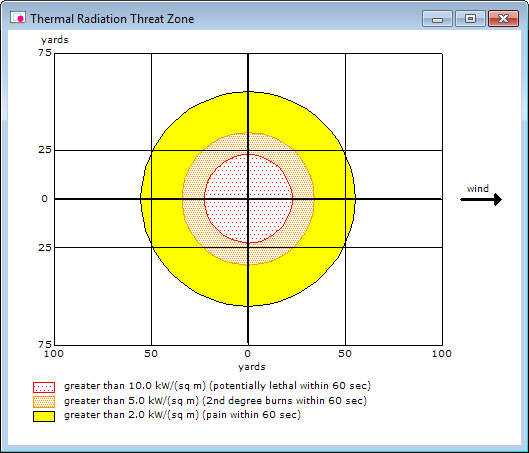Thermal Radiation Levels of Concern
In ALOHA, a thermal radiation Level of Concern (LOC) measures the threat associated with releases that are on fire; a thermal radiation LOC is a threshold level of thermal radiation (heat), usually the level above which a hazard may exist. When you run a pool fire, jet fire, or BLEVE (Boiling Liquid Expanding Vapor Explosion) scenario in ALOHA, thermal radiation is the hazard that is modeled.
ALOHA's Default Thermal Radiation Levels of Concern
Unlike toxic LOCs, no well-defined guidelines or standards exist to evaluate the thermal radiation hazard. So, ALOHA uses default thermal radiation values (in kilowatts per square meter) that are based on a review of several widely accepted sources on thermal radiation:

- 10 kW/(sq m) (potentially lethal within 60 seconds)
- 5 kW/(sq m) (second-degree burns within 60 seconds)
- 2 kW/(sq m) (pain within 60 seconds)

Using Other Thermal Radiation Levels of Concern in ALOHA
If you prefer, you can enter up to three thermal radiation values of your own (rather than use the default values). On the Thermal Radiation Level of Concern dialog box, simply choose "User specified" from the drop-down list of LOC values and type in your own LOCs. When setting your own LOCs, you may want to refer to the table below.
Note: The durations that correspond to effects like pain or second-degree burns can vary considerably, depending on circumstances. The effects above were observed on bare skin that was exposed directly to the thermal radiation. Some types of clothing can serve as a protective barrier against thermal radiation and can affect the exposure duration. However, exposure duration should be kept to a minimum, even at low levels of thermal radiation.
| Radiation Intensity (kW/m2) |
Time for Severe Pain (seconds) |
Time for 2nd Degree Burns (seconds) |
|---|---|---|
| 1 | 115 | 663 |
| 2 | 45 | 187 |
| 3 | 27 | 92 |
| 4 | 18 | 57 |
| 5 | 13 | 40 |
| 6 | 11 | 30 |
| 8 | 7 | 20 |
| 10 | 5 | 14 |
| 12 | 4 | 11 |
| Federal Emergency Management Agency, U.S. Department of Transportation, and U.S. Environmental Protection Agency. 1988. Handbook of Chemical Hazard Analysis Procedures. Washington, D.C.: Federal Emergency Management Agency Publications Office. | ||
Last updated
Tuesday, August 13, 2013 12:13pm PDT
 An official website of the United States government.
An official website of the United States government. 